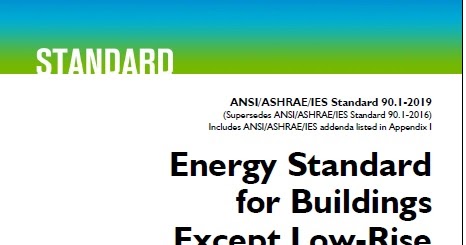


climate zones using commercial construction data. For each edition of the standard, these EUIs were then aggregated to a national basis for each prototype using weighting factors based on construction floor area developed for each of the 15 U.S. The resulting energy use from the complete suite of 480 simulation runs was then converted to energy use intensity (EUI, or energy use per unit floor area) metrics (Site EUI, Primary EUI, and energy cost intensity ) results for each simulation. The building simulations were conducted using the DOE EnergyPlus building simulation software. These prototypes were then modified in accordance with these 34 addenda to create a second suite of corresponding building simulations reflecting the same buildings compliant with Standard 90.1-2010. A suite of 240 computer energy simulations for building prototypes complying with ASHRAE 90.1- 2007 was developed.

However, out of the 109 addenda, 34 were preliminarily determined to have a measureable and quantifiable impact. Most addenda were deemed to have little quantifiable impact on building efficiency for the purpose of DOE’s final determination. All 109 addenda processed more » by ASHRAE in the creation of Standard 90.1-2010 from Standard 90.1-2007 were reviewed by DOE, and their combined impact on a suite of 16 building prototype models in 15 ASHRAE climate zones was considered. The final analysis considered each of the 109 addenda to ASHRAE Standard 90.1-2007 that were included in ASHRAE Standard 90.1- 2010. Department of Energy (DOE) conducted a final quantitative analysis to assess whether buildings constructed according to the requirements of the American National Standards Institute (ANSI)/American Society of Heating, Refrigerating and Air-Conditioning Engineers (ASHRAE)/Illuminating Engineering Society (IES) Standard 90.1-2010 (ASHRAE Standard 90.1-2010, Standard 90.1-2010, or 2010 edition) would result in energy savings compared with buildings constructed to ANSI/ASHRAE/Illuminating Engineering Society of North America (IESNA) Standard 90.1- 2007(ASHRAE Standard 90.1-2007, Standard 90.1-2007, or 2007 edition).

However, out of the 109 addenda, 34 were preliminarily determined to have measureable and quantifiable impact. Most addenda were deemed to have little quantifiable impact on building efficiency for the purpose of DOE’s preliminary determination. All 109 addenda processed by ASHRAE in more » the creation of Standard 90.1-2010 from Standard 90.1-2007 were reviewed by DOE, and their combined impact on a suite of 16 building prototype models in 15 ASHRAE climate zones was considered. The preliminary analysis considered each of the 109 addenda to ASHRAE Standard 90.1-2007 that were included in ASHRAE Standard 90.1-2010. The United States (U.S.) Department of Energy (DOE) conducted a preliminary quantitative analysis to assess whether buildings constructed according to the requirements of the American National Standards Institute (ANSI)/American Society of Heating, Refrigerating and Air-Conditioning Engineers (ASHRAE)/Illuminating Engineering Society of North America (IESNA) Standard 90.1-2010 (ASHRAE Standard 90.1-2010, Standard 90.1-2010, or 2010 edition) would result in energy savings compared with buildings constructed to ANSI/ASHRAE/IESNA Standard 90.1-2007(ASHRAE Standard 90.1-2007, Standard 90.1-2007, or 2007 edition). However, out of the 44 addenda, 9 were preliminarily determined to have measureable and quantifiable impact. All 44 addenda processed by ASHRAE in the creation of Standard 90.1-2007 from Standard 90.1-2004 were reviewed by DOE, and their combined more » impact on a suite of 15 building prototype models in 15 ASHRAE climate zones was considered. The final analysis considered each of the 44 addenda to ANSI/ASHRAE/IESNA Standard 90.1-2004 that were included in ANSI/ASHRAE/IESNA Standard 90.1-2007. The United States (U.S.) Department of Energy (DOE) conducted a final quantitative analysis to assess whether buildings constructed according to the requirements of the American National Standards Institute (ANSI)/American Society of Heating, Refrigerating and Air-Conditioning Engineers (ASHRAE)/Illuminating Engineering Society of North America (IESNA) Standard 90.1-2007 would result in energy savings compared with buildings constructed to ANSI/ASHRAE/IESNA Standard 90.1-2004.


 0 kommentar(er)
0 kommentar(er)
